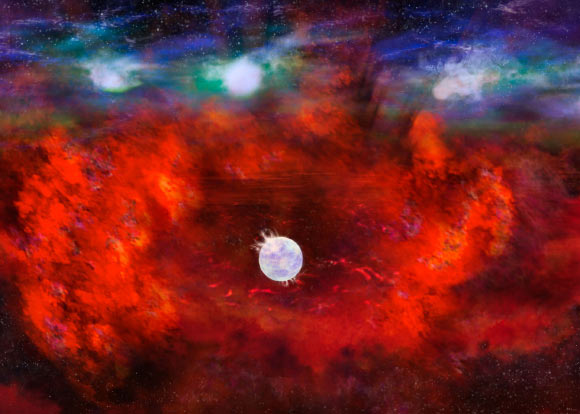Astronomers using the Atacama Large Millimeter/submillimeter Array (ALMA) have found new evidence that a very young neutron star is hiding deep inside the remains of the supernova 1987A (SN 1987A).
Source: Sci News
SN 1987A is a stellar explosion that occurred from a star about 20 times the mass of the Sun.
This supernova was first observed on February 23, 1987 in a nearby dwarf galaxy, the Large Magellanic Cloud, some 164,000 light-years away.
It was the first naked-eye supernova to be observed since Johannes Kepler witnessed a supernova over 400 years ago.
Ever since astronomers witnessed SN 1987A, they have been searching for a compact object that should have formed in the leftovers from the blast.
Because particles known as neutrinos were detected on Earth on the day of the explosion, they expected that a neutron star had formed in the collapsed center of the star.
But when they could not find any evidence for that star, they started to wonder whether it subsequently collapsed into a black hole instead.
Recently, observations from the ALMA radio telescope provided the first indication of the missing neutron star after the explosion.
Extremely high-resolution images revealed a hot blob in the dusty core of SN 1987A, which is brighter than its surroundings and matches the suspected location of the neutron star.
“We were very surprised to see this warm blob made by a thick cloud of dust in the supernova remnant,” said Dr. Mikako Matsuura, an astronomer at Cardiff University.
“There has to be something in the cloud that has heated up the dust and which makes it shine. That’s why we suggested that there is a neutron star hiding inside the dust cloud.”
“In spite of the supreme complexity of a supernova explosion and the extreme conditions reigning in the interior of a neutron star, the detection of a warm blob of dust is a confirmation of several predictions,” said Dr. Dany Page, an astrophysicist at the National Autonomous University of Mexico.

According to supernova computer models, SN 1987A kicked away the neutron star from its birthplace with a speed of hundreds of km per second.
The blob is exactly at the place where astronomers think the neutron star would be today.
And the temperature of the neutron star, which was predicted to be around 5 million degrees Celsius, provides enough energy to explain the brightness of the blob.
“The neutron star behaves exactly like we expected,” said Dr. James Lattimer, an astronomer at Stony Brook University.
“The supernova’s neutrino signal suggested that a black hole never formed, and moreover it seems difficult for a black hole to explain the observed brightness of the blob. We compared all possibilities and concluded that a hot neutron star is the most likely explanation.”
According to the team, the neutron star is a 25-km (15.5-mile) wide hot ball of ultra-dense matter.
Because it can only be 33 years old, it would be the youngest neutron star ever found.
The second-youngest known neutron star is located in the supernova remnant Cassiopeia A and is 330 years old.
Only a direct picture of the neutron star would give definite proof that it exists, but for that astronomers may need to wait a few more decades until the dust and gas in the supernova remnant become more transparent.
The findings were published in two papers in the Astrophysical Journal.
Source: Sci News

































Leave a Comment
You must be logged in to post a comment.